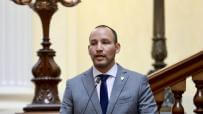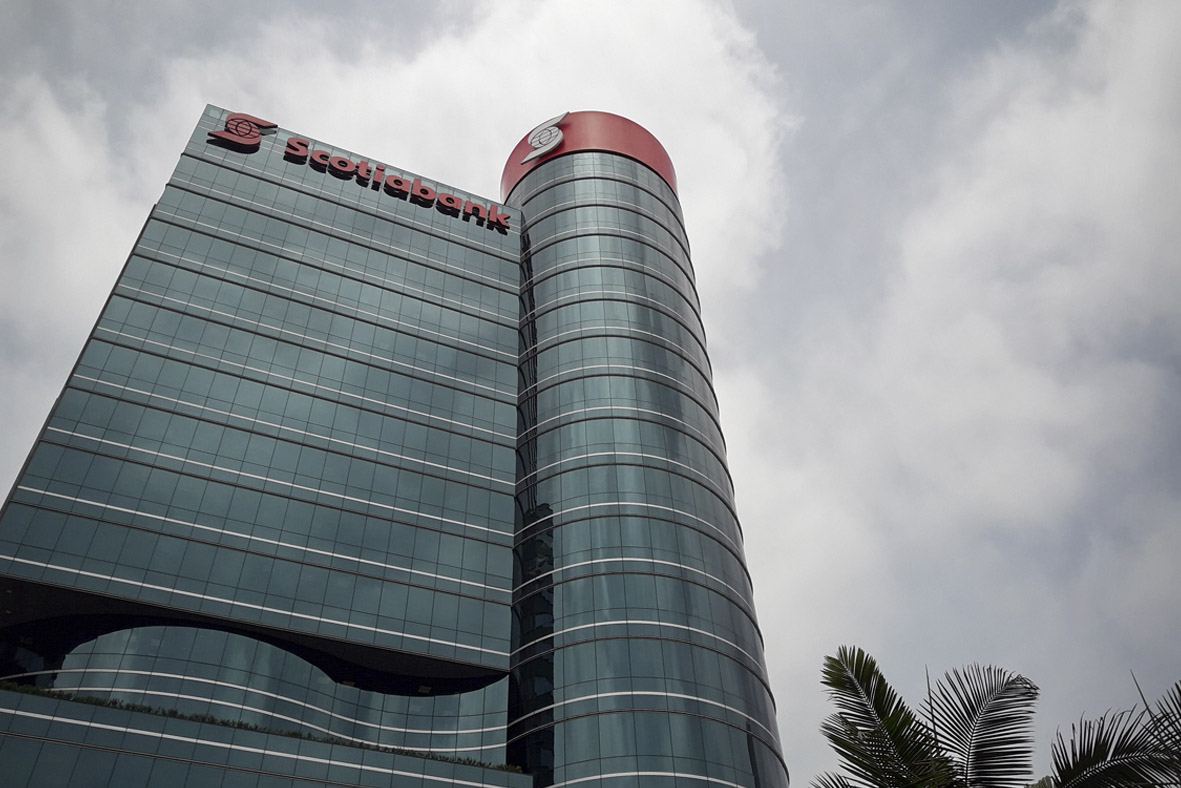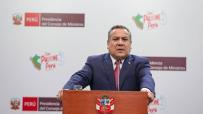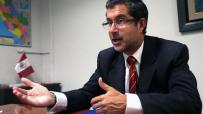
Scotiabank—Peru’s third largest financial institution and affiliated to Scotiabank Costa Rica, penalized this year for violating anti-money laundering regulations following revelations in the Lava Jato case—received deposits of than US$1 million from front men of Keiko Fujimori's party through pitufeo operations (large amounts of money banked through multiple deposits of small amounts) that disguised money delivered by the construction company Odebrecht as a contribution of the 2011 presidential campaign.
Based on documents from the Special Unit of the Public Prosecutor’s Office, Ojo-Publico.com has established that the allegedly illicit funds entered Scotiabank in two periods: US$50,000 in March 2010, through three different bank accounts in the name of Fuerza 2011 (the name of Keiko Fujimori’s political party at that time), and; US$997,000 between April 2011 (by which time it was already clear that Fujimori would contest a runoff against Ollanta Humala) and in June of that same year.
According to the declaration by the head of Odebrecht in Lima Jorge Barata, during 2010 and the beginning of 2011 the company delivered US$1 million to two important members of Fuerza 2011: Jorge Yoshiyama Tanaka and Augusto Bedoya Camere. According to the Public Prosecutor's Office, in order launder the money, the cash was deposited into the party’s Scotiabanks accounts through front men as if it were contributions from supporters of the Fujimori campaign.

MONEY LAUNDERING. Scotiabank, Peru’s third largest bank, received deposits into the accounts of Fuerza Popular totaling US$1 million of allegedly false contributors.
Photo: Ernesto Cabral / Ojo-Publico.com.
At that time, Scotiabank—a Canadian-owned bank that had entered the local market in 2006 after acquiring Wiese Bank—had more than 4,000 employees, 181 offices nationwide, and a special unit to prevent the entry of dirty money from criminal activities and terrorism.
According to a report by the Money Laundering Division of the National Police, more than half of the US$1 million given to Fujimori’s party from Odebrecht’s Structured Operations Department (or Caja 2) was transferred to the Scotiabank account of Fuerza 2011 through 110 cash deposits on almost every day of a single month—May 2011. The peak was reached on May 25, 2011—10 days before the runoff election between Fujimori and Humala—when 13 deposits were made totaling US$66,000.
Two years after these events, the Superintendency of Banking, Insurance and Pension Funds Administration (SBS) questioned how Scotiabank's anti-money laundering system had operated at the time of these deposits. As part of the DineroLeaks investigation about the degree to which the banking system is responsible when organized crime launders money, Ojo-Publico.com has established that the SBS did indeed investigate Scotiabank for “deficiencies” in the way it administered its anti-laundering operations.

SERIOUS MISCONDUCT. The Superintendency of Banking, Insurance and Pension Fund Administration (SBS) fined Scotiabank 25 Taxation Units (UIT) for "deficiencies" in its anti-laundering operations In August 2011, months after the presidential campaign.
Document: Ojo-Publico.com
In a 2013 sanctioning resolution only now revealed, the SBS concluded that Scotiabank displayed “deficiencies in the Registry of Operations”, the bank’s computer system that tracks transactions larger than US$10,000, which is a key threshold for detecting the unusual and suspicious transactions of its clients. Without revealing details, the regulator stated that the problem had occurred in August 2011 and noted that the investigation had allowed it to identify “inefficiencies in the minimum information that the registry should include.”

Dineroleaks. El Banco de Crédito, el BBVA Continental y otras entidades recibieron más de US$2.200 millones de clientes sospechosos
“As a result of the assessment undertaken (...) between September 26 and November 29, 2011 (...) it has been determined that there is evidence that the bank [Scotiabank] breached established protocols (...) for the Prevention of Money Laundering,” the SBS stated in a letter sent on October 10, 2012 to Carlos González-Taboada, the then general manager.
Because of the irregularities it detected, the SBS fined Scotiabank 25 UIT (S/. 92,500 at that time, equivalent to approximately US$30,000) for an offense considered serious under prevailing law. The General Superintendency of Financial Institutions of Costa Rica, the SBS’s counterpart in that Central American country, had fined the same bank in the amount of US$2 million for having allowed money from Odebrecht and Camargo Correa to pass to former president Alejandro Toledo without its money laundering prevention unit having issued a warning.
In this case, Scotiabank Peru received more than US$1 million through pitufeo operations into the accounts of the Fujimori’s party via deposits in March 2010 (US$50,000) and in the months of April (US$213,000), May (US$625,000), and June (US$158,000) of 2011. In its annual report for that year, the bank boasted that its “Asset Laundering Prevention Unit [minimized] Scotiabank Peru Group's risk of transactions involving laundering of assets in its various forms.” The evidence today from the Public Prosecutor’s Office and the SBS challenges that assertion.

PROFILE. Prosecutor José Pérez Gómez, in charge of the investigation against Keiko Fujimori, identified Fuerza 2011 contributors who made pitufeo deposits and in some cases did not prove they had the means to do so.
Photo: Andina
By 2011, when most of the money alleged to come from Odebrecht's entered Scotiabank, the SBS had already established that the pitufeo modality was a suspicious operation which banks, through their money laundering prevention compliance divisions, should report to the Financial Intelligence Unit within a period no longer than 30 days from the date of detection (since 2017 the timeframe has been reduced to 24 hours).
The same office of prosecutor José Domingo Pérez, in charge of the investigation against Keiko Fujimori and those who lead her party, advised that in May of this year it had received a letter from Scotiabank with “brief” information on the entry of illicit money from Odebrecht. According to the case report prepared by the prosecutor’s office: “There are people who contribute with significant amounts of money [in Scotiabank]; what is striking is that (...) they were not undertaken through a single deposit, but through small or divided up deposits.”
The SBS sent Ojo-Publico.com documents related to the penalty against Scotiabank, but redacted the paragraphs that contain the details of the accusations “because they included information protected by the Personal Data Protection Law.” It also declined to provide statistical information from the suspicious transaction reports issued by this financial institution during the 2010 and 2011 presidential campaigns, which it considered information “confidential under law.”

IN BLANK. The Superintendency of Banking, Insurance and Pension Funds Administration (SBS) redacted the paragraphs that detail the irregularities by Scotiabank in the administration of its anti-laundering operations.
Document: Ojo-Publico.com
For their part, Scotiabank officials stated that the law prevented them from answering Ojo-Publico.com’s questions about the receipt of alleged Odebrecht money in their vaults through the pitufeo operations. According to a letter from the bank's Institutional Relations and Social Responsibility Department: “Scotiabank is an institution that respects local and international law and responsibly meets all regulations related to good compliance practices.”
However, the story below, which is based on the investigations by the Public Prosecutor's Office, shows the opposite.
Pitufeo operations at the headquarters of Scotiabank in Lima
According to the case documents, Fuerza 2011 used two groups of front men to deposit Odebrecht´s US$1 million in Scotiabank. The first group consisted of natural persons or legal entities who lent their name, or whose identity was used, as front-line agents for deposits into the bank. The second group included people who visited different branches of the financial institution in Lima to deposit small amounts in cash during 2010 and 2011.
The Public Prosecutor's Office identified 44 payees in Scotiabank as suspicious contributors used by Fuerza 2011 to conceal Odebrecht money, with the following individuals recording the highest sums: Celso Dextre Cuaresma (US$68,000), Pierre Gonzalez Castelli (US$61,000), Gustavo Caillaux Zazzali (US$61,000), Eduardo Montes Vize (US$50 thousand), and Giancarlo Bertini Vivanco (US$65,000). Vivanco, who, together with his wife, contributed as a natural person, is also the owner of the Italia Import Export company.

PITUFEO OPERATIONS. The Public Ministry identified more than 40 people who deposited large amounts of cash in small amounts into Scotiabank for the accounts of Fuerza 2011.
Document: Ojo-Publico.com
When one such depositor of funds, the Bolivian diplomat Montes Vize, was called to testify before the Prosecutor's Office, he said he made a “single contribution for the candidacy of his daughter [Irma Montes Patiño in the 2011 Congress elections], money that had not been banked since he had it in his house and it came from the sale of a property in 2008 (...).” Before the Public Prosecutor’s Office, Montes Vize indicated that “his daughter gave him Scotiabank’s account number on behalf of Fuerza 2011” to deposit the money.
When the Public Prosecutor’s Office analyzed the supposed contribution of US$50,000 from Montez Vize—who will again be called by the prosecution together with Irma Montes—it discovered that the total had been divided into seven deposits in Scotiabank: US$8,000 in cash on March 2, 2011; three additional deposits in cash the following day totaling US$8,000, and; another three on March 4, two in the amount of US$5,000 and one for US$8,000.
Former Fujimori government minister Gustavo Caillaux Zazzali, whose declared contribution to Fuerza 2011 was US$61,000, followed the same procedure. When the Prosecutor's office analyzed the Scotiabank deposits, it discovered that the total had been divided into nine contributions: two deposits of US$7,000 and one for US$6,000 on May 2, three deposits of US$8,000 and one for US$4,000 on May 3, a deposit of US$8,000 on May 5, and, on May 13 a deposit of US$5,000.

LEADERSHIP. A month ago the Judiciary ordered the preventive detention of Keiko Fujimori, who is accused of leading a criminal organization in Fuerza Popular and laundering illicit money from Odebrecht during the 2011 campaign.
Photo: The Judiciary
The Special Unit also identified Luis Miguel Sánchez Tapia, today general manager of the well-known advertising agency Havas Media, as having used the same procedure. In a single day—May 23, 2011—he made four deposits of US$11,000 into the accounts of Fuerza 2011 (today Fuerza Popular) at Scotiabank.
Under interrogation by the Prosecutor’s Office Sanchez Tapia said, “We made four different deposits for security reasons (...) at a bank agency in San Isidro.” When asked about the deposit slips, he said that he had given “them to a person he did not know.”
“Two years later, in 2011 the SBS questioned Scotiabank's anti-money laundering system when the Odebrecht’s money entered.”
The Prosecutor's Office also identified Pierre Gonzalez Pérez Velasco (son of Pierre Gonzalez Castelli), who, on May 25 (two days after the deposits by Luis Sánchez Tapia) deposited a total of US$20,000 into Fuerza 2011’s Scotiabank account over four suspicious transactions: two each in the amount of US$5,000, one for US$4,000 and another for US$6,000. On May 31 Carlos Dávila Segovia, another alleged false contributor, made three deposits in cash into Scotiabank amounting to US$15,000.
In the second group, Public Prosecutor's Office identified Daniel Mellado Correa, one of the Bertini Vivanco’s principal operators and today fugitive from justice. He is accused of being one of the main Odebrecht’s principal couriers. On a single day—March 9, 2011 (one month before the presidential elections)—he pitufeoed a total of US$25,000 into Fuerza 2011’s bank account in Scotiabank.

SUSPECT. Daniel Mellado, considered one of Odebrecht’s principal money couriers, deposited US$6,000 at a Scotiabank agency in Miraflores as part of a pitufeo operation.
Photo: Google Maps.
According to Mellado's statement to prosecutors, he deposited US$5,000 and US$7,000 in cash in two Scotiabank agencies in Surquillo, one located between avenues Tomás Marsano and Guardia Civil, and another at the intersection of the Angamos and Republica de Panama. “The woman at the bank counter asked me to provide some information for filling out the 'LAVA format', which was at the bank request’s regarding the origin of the money. She then asked me the name of the contributor, but I do not remember which name I gave (...) and they proceeded to give me the voucher,” he said.
That same day, Mellado made two further cash deposits (US$7,000 and US$6,000) at the agencies located near the Angamos Hospital (Miraflores) and at the intersection of Petit Thouars and Río de la Plata (Miraflores). As he explained during the investigations into Keiko Fujimori and the upper echelon of her party: “using the same procedure, that is, entering the bank agency, standing in line, reaching the counter and announcing that the deposit of funds (...) for the Fuerza 2011.”
Dirty money in Scotiabank at Tarapoto
The Special Unit of the Public Prosecutor's Office also detected the deposit of US$35,000 in the Scotiabank agencies of Tarapoto (San Martin) via six individuals whose financial situation did not suggest they could afford contributions of this size. At the prevailing exchange rate, Lilith Sánchez Bardales and Gregoria Vela Arista each deposited US$5,000. Each declared to the prosecutor that she had kept the money in the dresser at home.
The office of prosecutor Pérez Gómez also identified a deposit for US$5,000 made by Niczer Romero Villalobos, who testified: “Mrs Gregoria Vela told me, ´You have to say that (...) you deposited in Scotiabank Tarapoto´ (...) I did not say anything to her but I wondered how I was going to be able to say that if I can’t justify the money. I live in a small house.”

FAKE CONTRIBUTOR. Niczer Romero Villalobos of Tarapoto was another of the alleged front men used by Fuerza Popular in the 2011 campaign.
Photo: La Republica Newspaper
It was the same with Guzman Rimarachin Diaz, who deposited US$5,000 in March 2011 at a Scotiabank branch in Tarapoto. The defendant said that the funds came from a “loan [he] obtained from the savings and credit union Caja de Paita around 2010.” However, the Prosecutor's Office found this explanation “implausible.”
The prosecution identified the same procedure in the cases of Irma Carranza Montenegro and Marizol Valles Chong (the wife of Fujimori party congressman Rolando Reátegui), who deposited US$5,000 and US$10,000 respectively at the bank's headquarters in San Martín. Under questioning by the Public Prosecutor’s Office, both women said that the money came from their savings. Shortly afterwards, cornered by the evidence, Reátegui went into witness protection. The rest is history.
 Tienes reportajes guardados
Tienes reportajes guardados
















